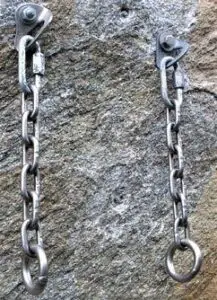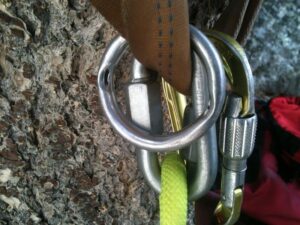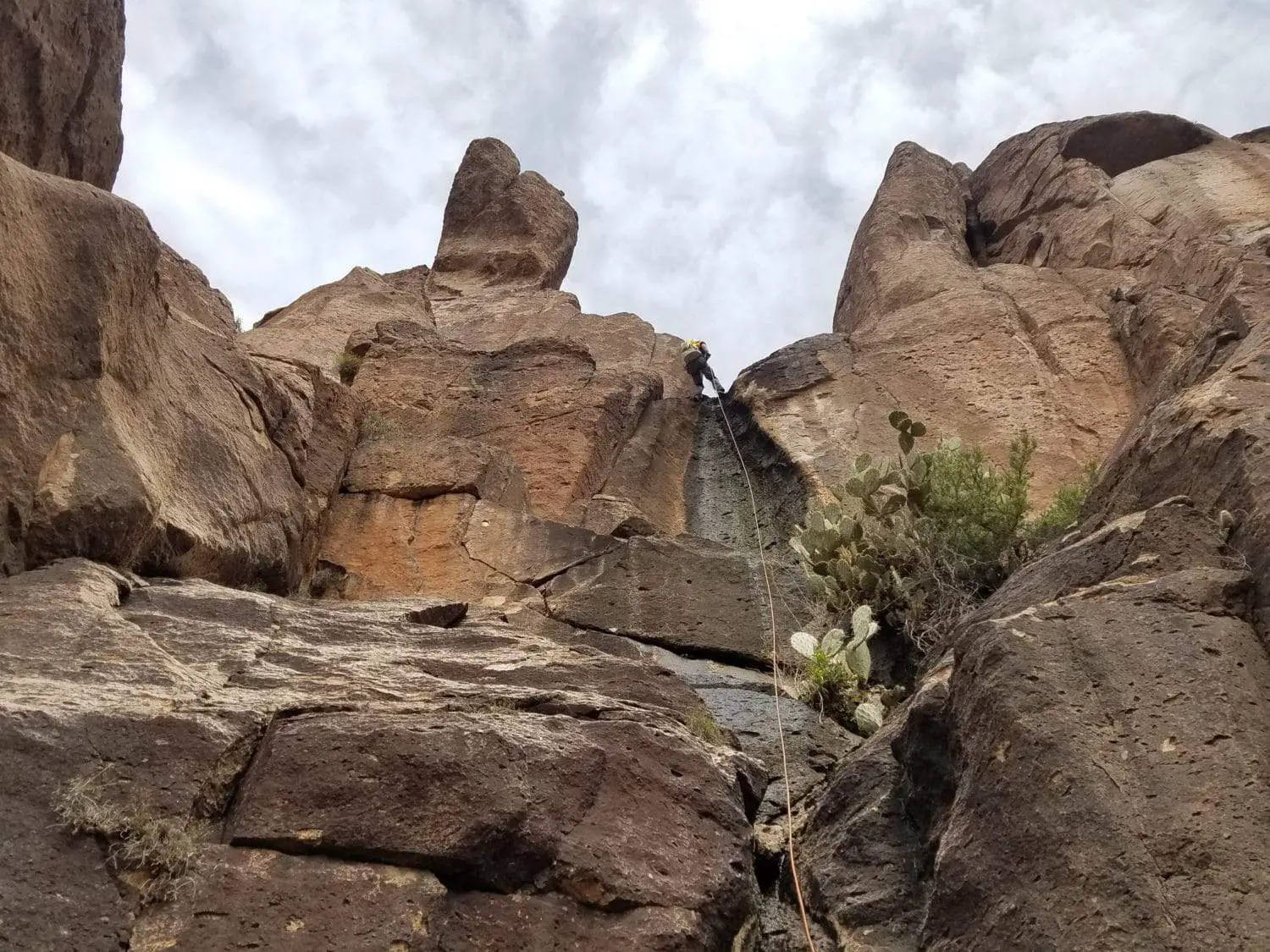Rap rings are a staple in any climber’s rack. They’re inexpensive, durable, and they make a nice noise when they jingle together on your harness.
What is a Rappel Ring? A rappel ring is a ring of metal that is either rolled, welded, or forged into a ring with no opening. They have pretty much been around since the modern beginning of climbing and mountaineering, and serve specific purposes in ropework and anchor building.
What are Rappel Rings For? Rappel rings are used for anchor building and maintaining to keep the rope from wearing through webbing or other anchor materials. “Rap Rings” are used in a variety of applications between climbing, canyoneering, mountaineering, caving, and rappelling.

They are not designed or intended to be used to rappel like a belay device , though it can be done in an emergency. People often use Quicklinks
, though it can be done in an emergency. People often use Quicklinks or Carabiners
or Carabiners  instead of rap rings, as they can more easily be removed.
instead of rap rings, as they can more easily be removed.
Rappel Rings, also called O-rings, can be made out of several different metals, and can be either solid or hollow. Each of these materials and designs have different applications, which are discussed in more detail ahead. They don’t last forever, and should be inspected prior to each use.
Why use a Rappel Ring?
Rappel rings are an inexpensive piece of gear that can be replaced as it wears over time. They serve slightly different functions between rock climbing and rappelling, as explained below:

Rappel Rings in Rock Climbing:
In a rock climbing application, steel rappel rings are often added to the bottom of fixed chain anchors. Because there is no opening, they have to be added with a locking carabiner or a quicklink/rapide. The nice thing about using rappel rings instead of quicklinks is that, because they are round, they wear more evenly than a quicklink. Additionally, they can’t come open or undone unintentionally.
Rap rings are cheap ($2-$5 USD) and can be replaced as frequently as needed. It is very important to inspect the whole ring before tying into it, as worn areas may be hidden by the connecting links. Feel around the ring for burrs, or shaving of metal that can damage your rope. These can be caused by metal-on-metal contact, though they rarely happen to steel rings.
In general, it is frowned upon to thread the rope directly through the chain links, quicklinks, or rap rings on the anchors. Repeated rope friction can wear through the metal of the anchor over time. Be especially wary of the small, hollow aluminum rap rings as they wear out more quickly and can lose their structural integrity once they wear part of the way through.
Local climbing etiquette usually dictates whether you can top rope directly through the anchor rappel rings or whether you need to supplement with your own gear (usually with a set of quickdraws ). It’s best to wear out your own gear instead of the communal gear left on anchors.
). It’s best to wear out your own gear instead of the communal gear left on anchors.
If you notice that rappel rings, or any other piece of anchor gear, are wearing out, contact your local climbing organization to make sure they get replaced in a timely manner. Consider contributing to these local groups with their bolt and hardware replacement work, as the cost adds up quickly!
Rappel Rings in Rappelling and Canyoning:
Rappel rings serve as the point of contact for the rope during a rappel, rather than just tying into tubular webbing . When rappelling, the rope needs to slide smoothly across the anchor point at the top until you reach the bottom of the cliff. While setting a rope to slide across webbing may work a few times, the rope will quickly act as a saw and cut right through the webbing. If you cut through your anchor, you fall!
. When rappelling, the rope needs to slide smoothly across the anchor point at the top until you reach the bottom of the cliff. While setting a rope to slide across webbing may work a few times, the rope will quickly act as a saw and cut right through the webbing. If you cut through your anchor, you fall!
A rap ring makes it so the rope slides with very little friction across the metal instead of sawing through webbing. Over long periods of time or during certain conditions repeated rope friction will wear through a rappel ring. It’s important to always check the condition of the ring before trusting your weight on it. Materials like aluminum wear out much faster than stainless steel or titanium.
Rappel rings, and quicklinks, made of strong stainless steel will generally last for a long time. Rope cause very little friction on the hard metal. This can change drastically during muddy and sandy conditions. I’ve seen a wet and sandy rope cut through a rappel device during a short 30ft (10m) rappel. The same thing can happen to rappel rings in those conditions.
Rappel rings are relatively cheap ($2-$5 USD), so it isn’t a big deal to have to leave one behind if you can’t build a retrievable anchor . The only downside with using them for canyoning is that you have to thread the rope through starting at the end instead of just unscrewing a quicklink and putting the middle of the rope through. This is especially frustrating when setting up a rope block
. The only downside with using them for canyoning is that you have to thread the rope through starting at the end instead of just unscrewing a quicklink and putting the middle of the rope through. This is especially frustrating when setting up a rope block and using a full ropelength.
and using a full ropelength.
It is common to come across old, unusable webbing with a quicklink or rappel ring in decent condition. Inspect the hardware before reusing it, but they usually are fine if there are no signs of wear or rust. Canyoneering etiquette usually dictates to clear away the nest of old, worn out webbing prior to moving on in order to maintain a minimal impact in the canyon.

Rappel Ring vs. Quicklink
Rappel Rings are solid forged or welded rings, whereas quicklinks (also known as rapides or rapid links) are oval-shaped and have a gate that screws shut. They are both used in rock climbing and rappelling, often interchangeably.
While there are a few advantages to a rappel ring, I prefer using quicklinks because they are more versatile.
Pros:
- Rappel rings don’t wear out as fast because they are round. The friction from pulling ropes won’t happen in the same place every single time, which slows the wear. With a quicklink, the friction wears down the same spot on every rappel and rope pull.
- A rappel ring can fit any diameter rope used for climbing and rappelling. The quicklinks that people leave on the mountain are not always wide enough to fit an 11mm rope through, as there are lots of different sizes for sale at hardware stores.
- Because the center of a rap ring is often bigger than a quicklink, it can be easier to pull the rope through once you’re on the ground. There is also less chance of the rope getting caught on the quicklink’s screw gate.
- Although the risk is minimal, a quicklink could theoretically upen up due to gravity and rope friction. A welded rap ring will never open up. There could also be problems with the quicklink gate in frozen conditions.
Cons:
- Rappel rings are inconvenient because they cannot easily be added to bolts, chain links, or webbing that is already tied. Quicklinks unscrew and can be attached to anything they need to. This is probably the biggest reason that I use them over rappel rings.
- Quicklinks are extremely cheap, and very easy to get ahold of. You can pick them up at any hardware store, or even at Walmart. Rap rings are pretty much only available as climbing gear. This drives the cost up a little bit, and the convenience down.
- I always carry quicklinks on the loops on my harness, connected to exterior loops on my rope bags, and really just all over everything so that they are readily available if I need to bail off of a route. To carry rappel rings around you have to either put them on a carabiner or a rope sling.

How to tell if a Rappel Ring is safe:
Whether you are climbing or rappelling, you will often encounter rappel rings people have left behind. It may be that they are trying to be nice, or it may be that they don’t know how to rappel without leaving gear behind . Whatever the case, you need to carefully evaluate the integrity of the ring as if your life depends on it- because it does!
. Whatever the case, you need to carefully evaluate the integrity of the ring as if your life depends on it- because it does!
- Spin the rappel ring around looking for any signs of grooves in the metal from rope contact. It is a judgement call as to when you should replace them, but I think it’s better safe than sorry! Spinning them will ensure that they don’t wear through in the same spot each time.
- Feel the inside of the ring for any sharp metal burrs. These can happen if someone uses a metal-on-metal connection like an aluminum carabiner connected to a rap ring.
- Check the weld, if there is one, and make sure it is still solid. If the ring has any gaps or is only pressed together, don’t use it.
- Make sure the rappel ring is round. If it is oval shaped, it could mean that too much force was applied which ruins the structural integrity of the ring.
- See if your stopper knot or rope block will fit through the ring. Rappel rings come in different sizes. If your rope block is small enough to get wedged into the ring, it could make you fall.
- A rappel ring is only as good as the rest of the anchor it is connected to. Carefully inspect the metal hardware or nylon webbing above it, looking for any signs of wear and tear like rust or sun fading. When in doubt, replace it!
How to use a Rappel Ring
The way you use a rappel ring will depend on the application, whether it be rock climbing, canyoning, slack-lining, hammocking, or actually rappelling.
Using a Rappel Ring for Rock Climbing:
- Secure yourself to the anchor using a personal anchor system.
- Connect the rap rings to the anchor point using quicklinks. There should be two anchor points that are parallel to each other.
- Clip a quickdraw to each rappel ring so that the gates face opposite directions.
- Thread the rope through the quickdraws so that they don’t force the rope into the rock. This would significantly increase the wear on the rope and the likelihood of the rope getting stuck.
- Tie yourself back into the rope using a figure eight knot, check the system, and have your belayer lower you down.
- Alternatively, to reduce the wear on your quickdraws, you can set up a rope block
 on one side and rappel down.
on one side and rappel down.
- Alternatively, to reduce the wear on your quickdraws, you can set up a rope block
Using a Rappel Ring for Rappelling and Canyoneering:
- Tie yourself in to an anchor point, or secure yourself in some way before going near the edge.
- Wrap the webbing around the natural anchor, threading it through a rap ring. Two are always better, but one will do in lower trafficked canyons. See our post on how to rig a rappel anchor
 .
. - Tie off the webbing so that if one strand were to give out the whole system wouldn’t fail.
- Thread the rope through the rappel ring and lower the end down to the ground.
- Tie into the rope, set up your rappel backup
 , and go!
, and go!
Using a Rappel Ring for Slack-Lining and Hammocking:
- Secure the anchor point around a tree or other fixed object, including a rap ring loosely on the webbing or rope.
- Secure one side of the slack line or hammock to the rap ring using a carabiner. If you don’t have a carabiner, but have another rap ring, there are ways of using the weighted system to lock itself in. I prefer to use a carabiner, but maybe that’s because I’m a climber.
- Repeat for the other side. Using a rap ring instead of clipping directly into the webbing will extend the life of the ropes and reduce the risk of sawing through webbing.
Which Rappel Ring to Buy?
They are all pretty much the same, as long as they are rated for climbing. You want at least 20kn of strength, and I prefer the ones that are solid instead of hollow because they last longer. In my opinion, the very small amount of weight you may save with a hollow ring is not worth the scare. Make sure you are getting a rap ring made of either steel or aluminum. Steel is preferred for rock climbing anchor building so that it lasts longer and resists burrs.
Omega Pacific makes some good, high-quality climbing gear. I have a full set of draws by them, and though they are a bit heavier than simple wire-gate quickdraws , I like them a lot. You see a lot of their rappel rings out in the wild because they don’t include welding marks which makes them perfectly round.
, I like them a lot. You see a lot of their rappel rings out in the wild because they don’t include welding marks which makes them perfectly round.
Amazon: Omega Pacific Rappel Ring
Can you Rappel with a Rappel Ring?
You CAN do a lot of things. Climbing gear is notoriously durable, and just plain useful; however, rappel rings are not designed to be used as belay devices. In fact, Omega Pacific explicitly states that theirs are not designed for rappelling or repeated lowering (lawyers, right?).
If, for some reason, you were in an emergency situation and only had a carabiner and rappel ring, there are ways to rappel. They are less safe than a belay device made for rappelling such as an atc or 8 ring, but it can be done.
How to Rappel with a Rappel Ring:
- Secure your harness. If you don’t have a harness, there are other options as explained in this article
 .
. - Pinch a bight of rope through the rappel ring and into the carabiner on your harness.
- Clip the downhill side of the rappel ring through the carabiner as well.
- Test the system before committing to going over the edge.
- When you get back home, clip an extra belay device and carabiner to your harness so you never have to rappel with a rap ring again!
Again, don’t ever plan on rappelling with a rappel ring. Hold on to your belay device, or learn how to rappel with multiple carabiners. A rap ring can work as a belay device in emergencies, and is probably safer than just using a carabiner and munter hitch.
See Also:
Is Speed Climbing Always the Same Route?

